

Originally posted May 18, 2017
As we have previously seen, Steyr Mannlicher's GB lost out to the Glock 17 in the 1970s competition to become the Austrian Army's new sidearm, propelling the Glock to ubiquity and the GB to expensive obscurity.¹ The GB limped along for a few years with commercial sales, but went out of production in 1988, having had its lunch comprehensively eaten by the Glock in Europe and the Beretta Model 92F in the United States.
The gang at Steyr didn't sit around feeling sorry for themselves for very long, though. They're Austrian. They analyzed the problem, took a hard look at the product that had defeated their hopes for domination of the Austrian military and police market, and carefully, methodically... hired someone from Glock. This gentleman, by the name of Wilhelm Bubits, had been a member of the team that selected the Glock 17 over the Steyr GB for the Austrian customs service, and had subsequently worked as a trainer for Glock, teaching police agencies' armorers how to look after the product. He was therefore... somewhat familiar with them. Let's see if it shows.
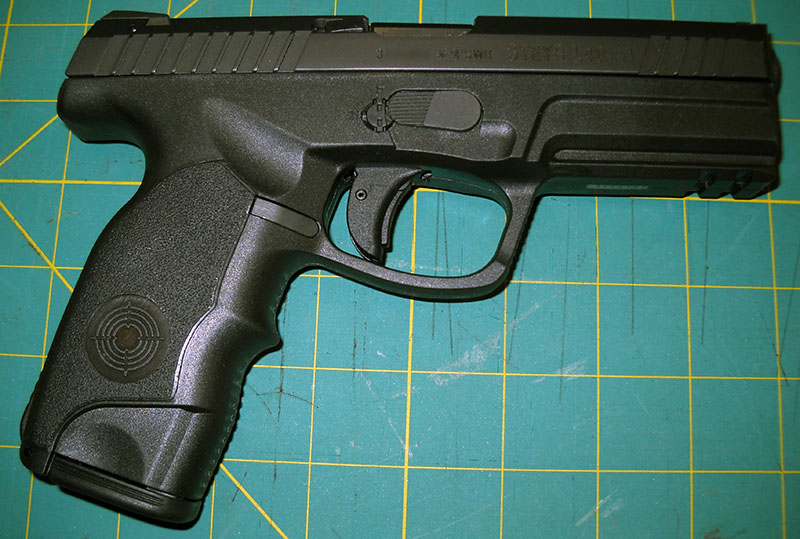
As you may remember from last time, the Glock is a polymer-framed pistol using a combination of a Browning tilting-barrel locking system and a semi-double-action-only, striker-fired ignition system, the latter similar in principle to that found in the old Roth-Krnka M.7. It has a trigger-within-trigger safety system and a tendency to support quite-high-capacity magazines.
Steyr's answer, which debuted as the M9 (not to be confused with the U.S. military's M9, which is a Beretta 92FS) and would later sprawl into a product line not quite as extensive, but nearly as comprehensive, as Glock's, is a polymer-framed pistol using a combination of a Browning tilting-barrel locking system and a semi-double-action-only, striker-fired ignition system, the latter similar in principle to that found in the old Roth-Krnka M.7. It has a trigger-within-trigger safety system and a tendency to support quite-high-capacity magazines.
If you can't beat 'em...
Of course, by 1999, when the original version of the M9 and its family hit the market, the Austrian armed forces weren't looking for a new pistol, which is why they still carry Glocks; but a good many police agencies in the German-speaking world were in the market, and the Steyr offerings did quite well with them. By then, a fair number of people in both police procurement departments and the civilian world were presumably looking around for things that weren't Glocks just to have things that weren't Glocks. The Steyr M series, in that capacity, reminds me of the joke that circulated when Google Plus first went live. "What is it?" "Not Facebook!" "What's it like?" "Facebook!" "Well, what the hell, that's all I really wanted."
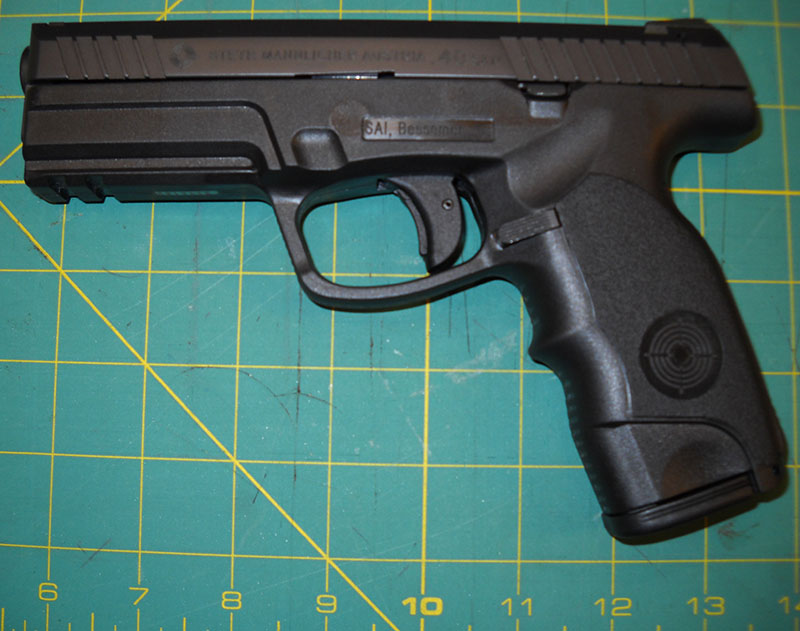
What we have here is a third-generation M-series, and as you can see from the markings, it's not actually an M-anything. The current Steyr pistol line is available in four sizes, which are reflected in their model codes: with all the wild imaginativeness we have come to expect from Austrian arms manufacturers, these designations are L, M, S, and... OK, well, C, and they mean just about what you think (the C is for Compact, which in this instance is smaller than Small). There's also a number, which reflects the cartridge used. For instance, the Steyr M9-A1 is the medium-sized pistol in 9mm Parabellum.
This one is an L40-A1, meaning it's the Large size (which I believe has the same frame as the M, but a longer slide/barrel assembly) in .40 Smith & Wesson, a cartridge which is itself a mildly interesting side story. We'll come back to that. First I have to explain why this pistol says "A1" in its model number, and yet is third-generation. That appears to be because the second-generation pistols, the original A1s, incorporated mechanical changes, while the third generation just has some changes to the grip molding and the shape of the slide. I think. Steyr's website isn't really forthcoming about the specifics. Anyway, somebody decided it was a big enough change to mention in the marketing materials, but not significant enough engineering-wise to warrant calling them A2 models.
Potential cultural collisions between Steyr's marketing and engineering departments aside, this is a pretty nifty pistol. It's tempting at first glance to dismiss it as a blatant clone of the Glock, and there's something to that, but there are a few differences worth taking a closer look at too.
The most evident difference on the outside is the layout. The grip is at a much sharper angle than the Glock's, enough to give it a sort of "raygun" profile, and the slide has quite a low profile, reminiscent of the CZ 75's (but without the inside-the-rails design). This is more obvious with the slide back:
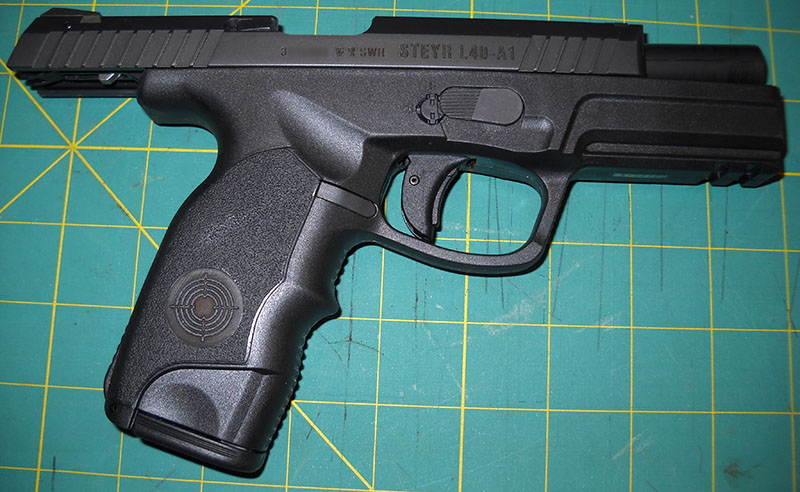
This puts the moving mass of the action, and the recoil axis, closer to the line of the shooter's hand and arm, which makes the muzzle flip up less and makes the whole thing more comfortable and controllable in rapid fire. And it works! It's quite a comfy pistol to shoot (although admittedly part of that, in the L model, will be because it's so big).
Takedown is pretty simple. That round bit above the trigger is a combination of two different things. By using one of the little keys that come with the gun, you can turn it 90° and lock the gun, making it impossible to fire, cycle, or disassemble. (I've read that the police versions take a handcuff key there, which is a nice touch if it's true.) This satisfies certain legislative impulses for providing ways of Positively Disabling stored firearms, which is a thing that's turning up on more and more new-production guns these days. If it's not locked, it's also a push button, and pushing it in allows the takedown lever next to it to be rotated downward.
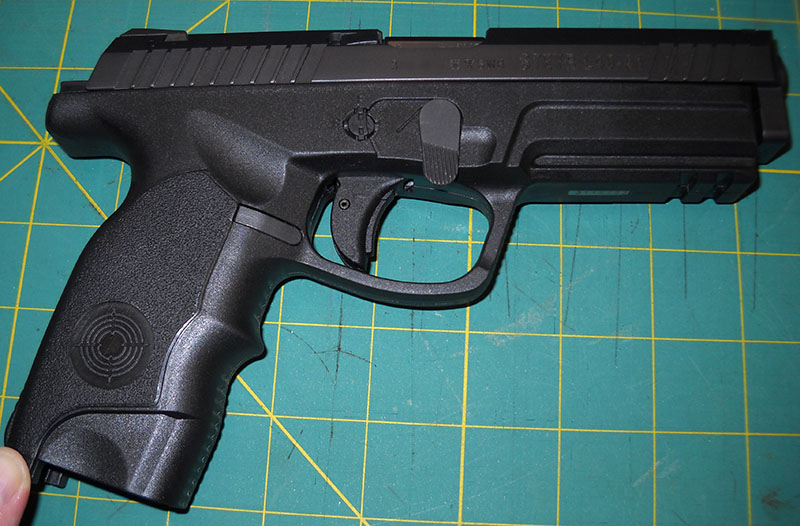
Once that lever is unlocked, the pistol comes apart in a manner that should be pretty familiar to regular readers by now.
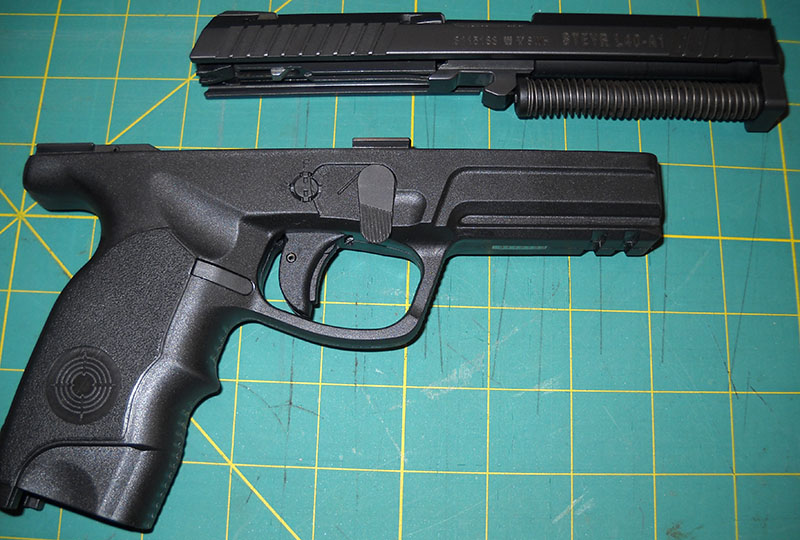
Not a lot of surprises in here, nor when you take the barrel/slide subassembly apart.
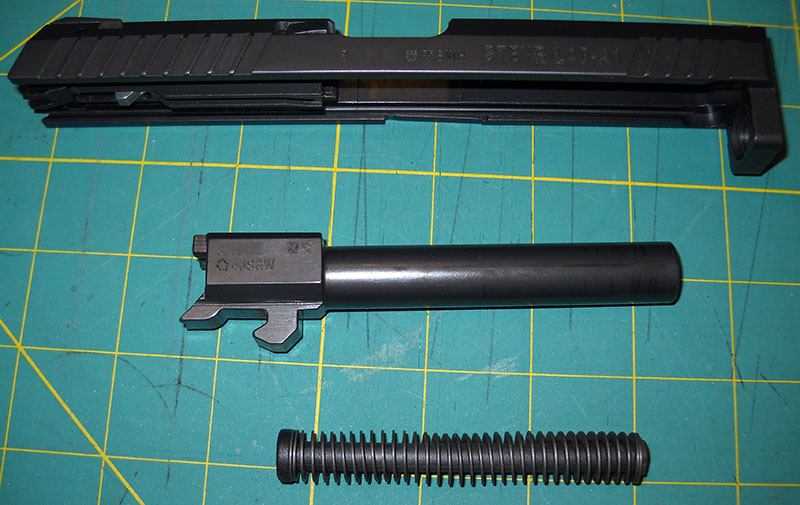
Have you noticed something? The Steyr even uses the same "big ol' block around the chamber instead of locking lugs" variation on the Browning system that Glocks use, though Steyr's chamber area is even beefier than Glock's tends to be.
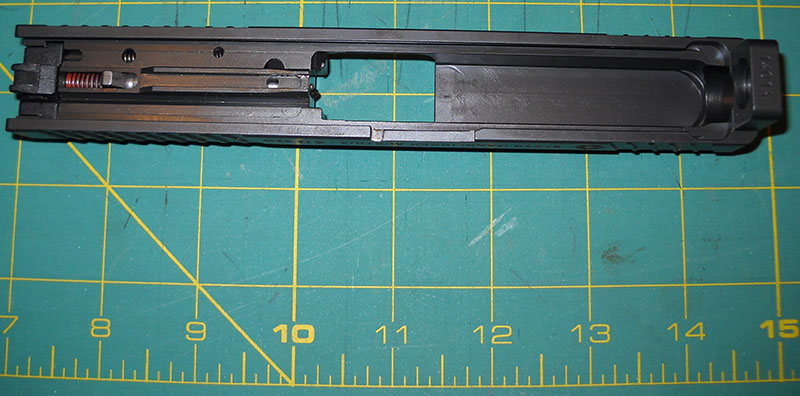
No lugs inside the slide, and a similar-looking (though not identical) striker block. As with the Glock, there's a tool you can get to take the striker assembly apart, but I don't have one, nor do I really have any need for one at the moment.

Meanwhile, inside the frame, we can see that Steyr followed the same strategy of fitting the polymer frame with a load-distributing steel block for the barrel cam/stop assembly. Note also that the slide rails are part of that steel piece, and consist only of those little short surfaces just ahead of the cam block, as well as another short pair all the way at the back (left side in this photo). Those four contact points are all there is, like the contact patches on a car's tires.
The Steyr's sights are interesting; they're in a conventional layout, blade up front and notch in back, but have some unique geometry going on that is supposed to make for quicker, more intuitive acquisition.
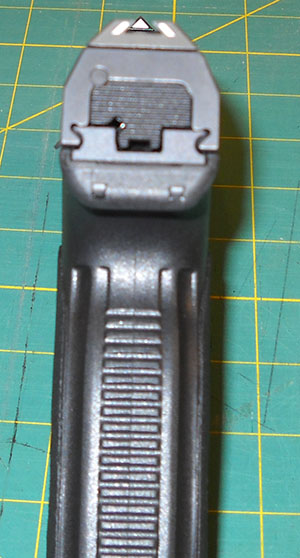
I didn't quite get it lined up properly there; the triangle is supposed to be completely within the slanted lines. Sighted as shown in the photo, the pistol would shoot slightly high. (In my defense, lining up a pistol's sights with a camera in one hand is hard!)
I promised a quick digression to talk about the ammunition this pistol uses, and here it is. .40 Smith & Wesson was developed in the late '80s for the FBI. The Bureau wanted something with similar terminal ballistics to the old .38 Special +P round that had been their standby for decades, but which could be used in medium-frame semiautomatic pistols. They fooled around with 9mm Parabellum and .45 ACP, the two most popular "service-grade" auto pistol rounds, but for various reasons neither one seemed to fit the bill; 9mm wasn't heavy enough, but .45 ACP doesn't really play well with medium-sized handguns.
It happened that the FBI agent in charge of the Bureau's firearms training, one John Hall, owned a Colt Delta Elite, which is a 1911-style pistol chambered for the ever-controversial 10mm Auto cartridge (as devised for the notorious Bren Ten). The Delta Elite was too big, and 10mm Auto far too demanding, for the FBI's purposes, but Agent Hall decided to see what would happen if he downloaded the cartridge by hand. What he (and some engineers from Smith & Wesson and Winchester, who were working on the project for the FBI) ended up with, after shortening the case a little bit (10mm Auto is 10×25mm, .40 S&W is 10×22mm), was pretty much exactly what the FBI wanted: a cartridge that would work well in a medium-sized pistol, but which still threw a bigger, heavier bullet than 9mm Parabellum.
Smith & Wesson promptly introduced a new pistol, the Model 4006, to chamber their new cartridge... only to have the always day-spoiling crew over at Glock beat them to the market for their own cartridge, dropping their models 22 and 23 a week before the Smith came out. (It so happened that Glock had recently come up with the 20, in the full-size 10mm cartridge, just a short time before, so they already had most of the tooling they needed to make barrels for .40 S&W too.) And so FBI agents carry Glock 22s. No good design goes unpunished...
(As an aside, I once saw an amusing online rant in which someone misread that to mean that the FBI had its agents carrying Glock .22s, and was flying off the handle about how utterly inadequate that was. Note that as far as I am aware, Glock does not make .22s.)
I had no particular agenda in buying the .40 S&W version of this pistol; it just so happened that, for reasons I'm not clear on, the L40-A1 was turning up nearly $100 cheaper than the L9-A1 when I went shopping. No idea why, they're virtually identical—in fact it used to be possible to buy a conversion kit to switch between the two, at least in the M-length slide—but there it is. The M-A1 was also available in .357 SIG (an odd cartridge which is 10mm Auto necked down to take a 9mm bullet), but I believe that variant has been discontinued now, at least in the US.
As for Wilhelm Bubits, he was last seen as chief designer of the Caracal (a polymer-framed, Browning-locked, semi-DAO-striker-fired pistol made in Abu Dhabi). Say what you will about the man, he's consistent. :)
On the range, this is a mild-mannered pistol for the cartridge it uses, partly because of the superior grip ergonomics and partly because the L type, in particular, is pretty big and heavy. I have no data on the more compact models, which are probably livelier because of their shorter barrels and lighter weight, but in photos they look like they have very similar grip designs, so they're probably pretty comfortable too for what they are. The one place where the user experience really falls down is the magazines, which are terrible to reload by hand. After my first very frustrating trip to the range with my L40, I bought a third-party magazine loading tool that I hope will make a big difference the next time I go. If I think of it, I'll try to do a follow-up on that whenever I get the chance to take it out and try it.
In the parallel universe where Glock never happened, Steyr M9-A1s are probably the most ubiquitous firearms in the galaxy. I wonder if they look as interesting and zippy to people in that universe, or if their ubiquity makes that spacegun profile seem dull and uninspired, prompting cries of "oh, not that plastic Austrian pistol again" on message boards throughout the local equivalent of the Internet.
--G.
¹ To be fair, that was not the only reason the GB sank into obscurity. There was also the small matter of the notoriously ropy American knockoff of same, the Rogak P-18, which pretty much ensured that no one in North America was ever going to take the GB seriously as a service pistol.